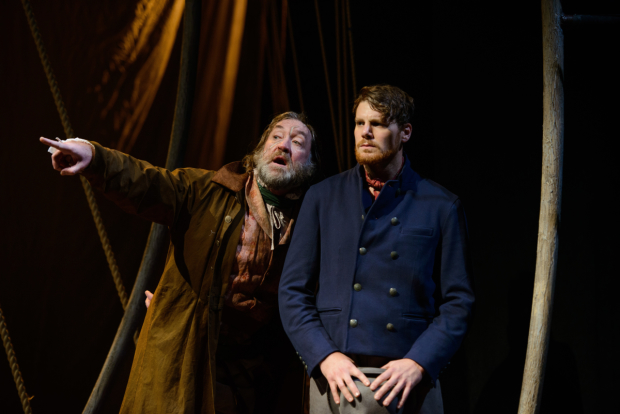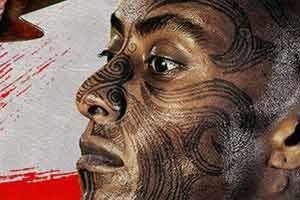
(© Greg Mooney)
In its presentation of Lookingglass Theatre Company's Moby Dick, Arena Stage brings to Herman Melville's 1851 novel all the best elements that modern drama can provide to classic storytelling: clarity, insight, and a fresh perspective.
Most of Melville's important central characters are present in David Catlin's adaptation: the narrator, who asks us to call him "Ishmael"; the Polynesian harpooner, Queequeg, his body and head covered in tattoos; the reasonable first mate, Mr. Starbuck; the cheerful second mate, Stubb; and the captain of the ship the Pequod, Captain Ahab, his left leg bound in leather at the knee, with a white prosthesis fashioned from whale jawbone from the knee down.
Like the novel, this Moby Dick examines Captain Ahab's obsession with catching the whale that bit off his leg. Ahab's 33 men, however, believe that they have been hired to kill whales in order to get their precious oil. While the Pequod in Melville's novel met nine other ships on its voyage, the Pequod in Catlin's drama meets only two. This adaptation compresses the original very effectively, without reducing it.
Jamie Abelson is excellent as Ishmael, who arrives in New Bedford, Massachusetts believing that his own search for meaning in life has led him to find out about whales. The audience slowly learns that Ishmael's voyage is inextricably joined to Ahab's monomaniacal quest for revenge. Abelson plays Ishmael as a slightly comical thinker rather than a physically tough seaman.
Anthony Fleming III is brilliant as Queequeg, enhancing both the comedy and the difficult physical requirements of this production. Playing the son of a king on Rokovoko Island, Fleming is impressive whether in speaking a prayer in his native language or saving the life of a sailor who has fallen into the sea.
Walter Owen Briggs is convincing as the Quaker Mr. Starbuck, whose firm religious faith allows him to expect that he will return home. He is the main opponent to Captain Ahab, when it is clear that Ahab has forsaken all whales but Moby Dick. Christopher Donahue is very good as Ahab, whose madness is thorough and searing. Micah Figueroa and Javen Ulambayer are essential to the production in their roles as sailors Cabaco and Mungun, respectively.
There are three women in this production, who play a variety of roles, from wives and mothers of the seamen to an Innkeeper (Kelley Abell), a Crone (Cordelia Dewdney), and a Widow (Dasey Foster). All three also take on the roles of the Fates and of whales, appearing with black umbrellas, opening and closing them to suggest the whales' breaching.
Catlin performs double duty here, directing his own adaptation. He very cleverly works with the Actors Gymnasium and acrobatic choreographer Sylvia Hernandez-Distasi to create a physical production that is active and safe. Set designer Courtney O'Neill constructs four metal semicircles, which spiral around one circle on the wall behind the stage, giving the impression of the inside of a whale. Sailors scale these semicircles and climb broad rope ladders that hang from invisible masts. During the intermission, rigging designer Isaac Schoepp's two long boats made of wood platforms hang on ropes that are suspended from the ceiling over the stage. When harpooneers take the long boats out to catch whales, these boats swing out over stage, nearly into the audience.
Costume designer Sully Ratke dresses the three women first in identical dark hoop skirts and red wigs. Once the Pequod is under way, the ocean is represented by one of the women standing in the center of the stage, wearing a skirt fashioned out of yards of dark blue silk, which ripples over every inch of the stage.
Lighting designer William Kirkham creates many subtle moods with his palette and spotlights. Rick Sims puts together a varied soundscape to suggest howling wind, crashing water, and creaking rope.
With only ten actors, this Moby Dick magically suggests the magnificence and majesty of Melville's story. Though not the same as the original novel, it is still an impressive quality of storytelling. With its simplicity, it manages to sum up a good deal of the infinite, elemental nautical world that Melville captured in his vast Moby Dick.









